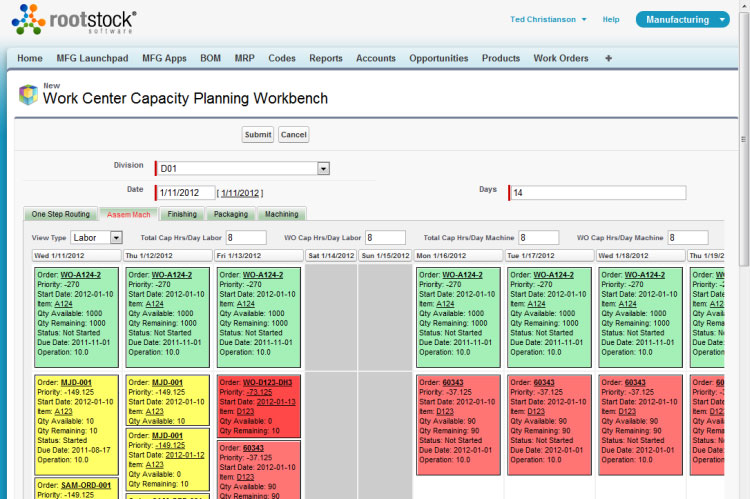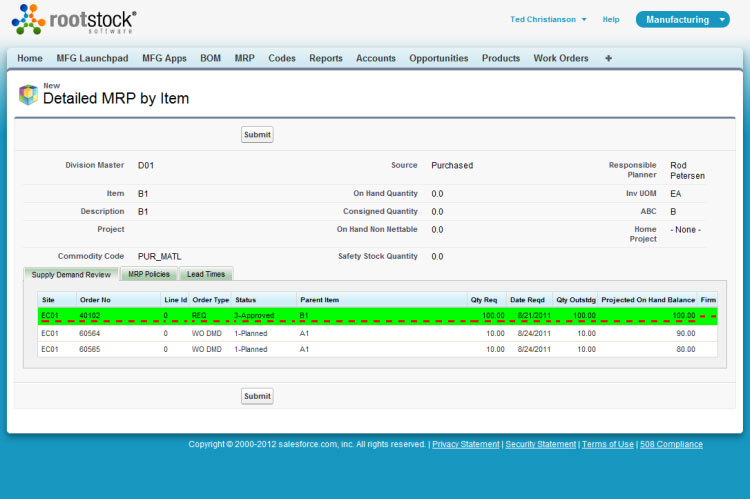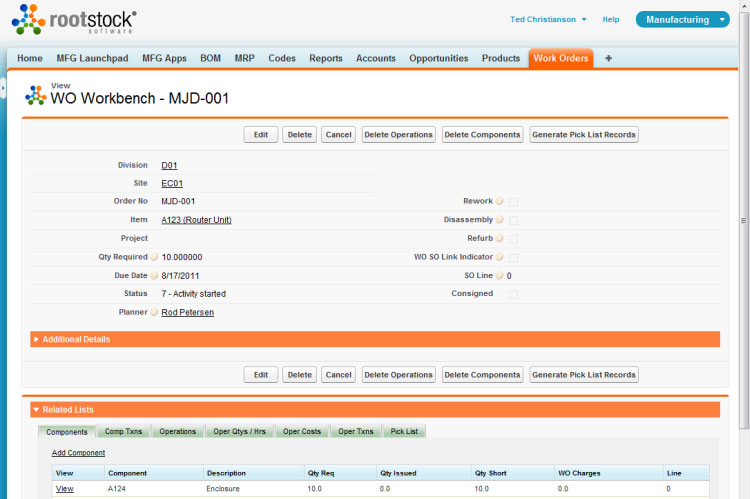Manufacturing
Rootstock COO Shares Why Manufacturing Should Go to the Cloud

Chuck Olinger is the COO of Rootstock Software and brings more than 35 years of experience in the development, marketing, and implementation of manufacturing systems to the Rootstock team. Rootstock Software provides cloud-based manufacturing and supply chain solutions built on the leading cloud platform, Force.com. Launched in 2008, Rootstock delivers comprehensive applications that enable manufacturers to leverage the power and flexibility of the Cloud.
For more information about Rootstock, visit their website and check out our Rootstock MFG Apps review.
What is Rootstock’s mission?

WEBSITE: www.rootstock.com
FOUNDED: 2008
LOCATION: San Ramon, California
SOLUTIONS: Rootstock MFG Apps
How was Rootstock founded? What was the inspiration to establish it?
Well, this is our third time around in developing this type of a system. We had sold our previous company, Relevant Business Systems—which we had for about 21 years—in February of 2006. It took a little time to decide what to do next. Our founder and CEO, Pat Garrehy, and I looked at a number of different things. We became convinced that the SaaS model and the Cloud platform were the wave of the future. So, we set out to deliver a robust application that was delivered via the new paradigm of the Cloud: better, cheaper, faster.
Why do you think people should care about Rootstock? What does Rootstock do differently compared to other ERP solutions in the market?
Number one, I think that we provide proven techniques but we also have adapted to the developments that have occurred in the manufacturing space over the years. The way people get products made today is not the same as it was 10 years ago or 20 years ago. So, we have the roots to deliver the proven concepts but we’ve also adapted to the new methodology of many things being outsourced and many things being done by contract manufacturers. We’ve done a lot to support the current methods that are being used in the industry. And then when you combine that with being one of the few substantial applications that is being delivered on the number one Cloud platform–which is the Force.com platform–we think that people are beginning to realize that this is the wave of the future, this is a system of the future, that the possibilities are unlimited as to what you can do to make your operations more efficient, more connected with your customers, and more connected with your suppliers. Things that have been promised for many, many years are now being delivered, and a lot of it has to do with the platform. That’s the reason we think people should be seriously considering Rootstock or some of the other cloud offerings.
The Cloud is a very hot topic in enterprise software, so how do you make sure Rootstock gets heard above all the noise?
We’ve always said it’s better to stand out than to be outstanding. However, we’re trying to be both. The way we’re doing that is by taking advantage of our longevity in this space and in the industry. But the way we’re getting our message out is by trying to aggressively work the trusted advisors and analysts, selectors and influencers, and in effect, continue to tell the story that we’re not just new kids on the block that decided we’re going to get into this business. We’ve been in the business for a long time; we have a lot of experience, but we’re bringing in the modern delivery mechanism.
The other thing we’re doing differently than some others we see in this space is that we are staying with the traditional method of discovering and uncovering the requirements of the client. Even with our implementations–although they are abbreviated and more rapid than in the past–we’re not taking the attitude that “Since it’s on the Cloud, you can do it yourself,” because applications like this are pretty serious and complex, in some cases. Therefore, we’re differentiating ourselves a little bit in that we’re willing to invest more of our own time in getting people up and running than what we believe some others are doing. People should be feeling more comfortable in that they’re not just buying something and being left to figure out how to put it together themselves. And, with the recurring revenue model that you get with the subscription and the SaaS model, we’re investing more heavily in making sure that the people who come on are going to stay on because you have to basically earn their business every year. We don’t want to have a lot of churn, which some of the other earlier Cloud guys have had.
Where do you think Cloud ERP and Cloud manufacturing are headed? Where do you see this area in five years?
We are optimistic. In the early days, people were concerned about data security. They were concerned about what happens if the Internet goes down. Those concerns seem to have all diminished significantly because there are proof points out there that cloud apps are solid; they can be mission critical and you can depend on them.
In general, we feel the same with manufacturing. We are optimistic that no matter what the political nature of our country is, manufacturing is a focus regardless of which party is going to be in power. When we look ahead at 5 years, we say manufacturing will have a resurgence and we believe that more and more companies as they begin to ramp up are going to remember, “It wasn’t so great when I bought Oracle or SAP. Why don’t I just go on the Cloud?” That’s our message: if you go in the Cloud, you can be much more nimble in how you rearrange your operating processes. Or, if you want to switch from one supplier to another supplier, it’s easy to have that all occur with the Cloud. If you have multiple operations throughout the world and you need to hook them up, give them a URL and sign on.

What challenges do you see ahead in this segment, and how do you think businesses can overcome these challenges?
The number one challenge is how fast the economy is going to recover; that’s a macro-economic topic that everyone has to worry about. I know I just said that people are becoming much more accepting of the Cloud, but when they start looking at manufacturing software there are a few offerings in the Cloud and there are a lot of offerings on-premise. And people will still evaluate, “Do I buy it or do I rent it?” It’s like buying a car: Am I buying a car or am I leasing a car? The cloud computing and the subscription model is never going to go all one way or the other in our opinion, but the challenge is getting that wave of acceptance going at a more rapid pace and velocity. We see a lot of that velocity building because of people like Salesforce and the various cloud offerings.
But, it’s still a challenge. There are still people who are followers. Many people are followers. Our challenge is making sure we get a few of the leaders committed to manufacturing in the Cloud. If we get a few of those leaders and we get some good recommendations out of them, we think the followers will start to get in line. I’m sure you’ve probably seen how a lot of the time people don’t want to look at the product. They just want to hear, “I heard five guys say it’s great so I’m going to go buy it.”
How do you think you can get leaders to become committed to the Cloud?
We’re seeing larger companies realize the benefits, companies like Kimberly Clark, Burberry, and other flagship brands out there that have adopted the Salesforce.com sales applications. But more than just their sales applications, all of the infrastructure and things that go along with the Force.com platform are being adopted. A lot of the IT organizations at the leading companies are really putting more and more emphasis and confidence in the Force.com platform and those are great stories and great confidence builders for some of these guys that are, like I say, followers. Corporate enterprise level guys are starting to make those decisions and say, “Hey, this stuff is really good. Why don’t I put more and more onto the Cloud, including things like my inventory control, my manufacturing, etc.”

What is the most exciting thing about Rootstock? What makes you excited about it?
I think it’s the combination of our robust functionality, the platform, and the accessibility of data at any time, anywhere. We’re able now to deliver the entire set of applications on an iPad, an iPhone, or Android. In today’s world, that’s very important. If you have an executive that’s traveling and he’s out of the country when he needs to see what’s going on in his factory, he pulls out his iPad and he can see what’s going on. These are things that we’ve talked about for a long time that are now very deliverable, so that’s exciting to us.
The other thing we’re excited about is that the Force platform provides this one common place where all the data can reside and where one common set of tools can be accessed. It’s amazing how many companies, both small and large, have on average 8-10 different applications that are all running on different platforms, different operating environments, and on a bunch of spreadsheets. Being able to knit it all together on one common platform is exciting.
The other thing that’s happening on the Force platform that they’re continuing to build out is the emphasis on social and connections. Within the manufacturing arena, we’d like to think more of collaborative communications via things like Chatter or if you do need to access something on Facebook, LinkedIn or Twitter, those are built-in features that you can add. We’re more focused on communication within the enterprise to generate efficiencies and get rid of duplications of communications going around. So that’s exciting too, seeing that we can use some of these features to have equipment on the shop floor communicate into these feeds that you have. So rather than finding out two days later that a machine went down, the president of the company can see it on his phone when he’s at lunch. So, that’s exciting stuff. Everybody’s talked about for a long time, but it’s now deliverable.

Rootstock recently completed a partnership with FinancialForce.com. Can you tell us more about that?
Our focus in building out our product has been on the manufacturing processes, starting from taking a sales order. In Salesforce, they’re using CRM, and they get that quote and push it back. We now pick it up as an order. That gives us information about the demand for the factory or the demand on the inventory. All of those things have an accounting implication. So our choice was to partner with FinancialForce and to have a very tight integration rather than building accounting applications. All the activities that impact accounting have open APIs that send information directly into the financials. In that whole process, we’ve become very close to the company. We collaborate on product roadmaps, we exchange technical information, and we also have a close business relationship with them.
Why did you choose to partner with FinancialForce?
They were the most recognizable and dominant accounting player native on the Force platform, so the benefit of having them native is that everybody’s data is all in one place protected by roles, permissions, and things like that. Secondly, FinancialForce is a joint venture between Salesforce and UNIT4, the parent company of FinancialForce. From a commitment platform and a commitment to the Force.com mission, they made sense. We do anticipate having some interaction with maybe SAP Financials or Oracle Financials and we structured our architecture so we can pass to a corporate set of books if necessary. The other thing is that Salesforce.com is an investor in Rootstock, as well as in FinancialForce, so keeping it in the family is important to us as well.
Who do you think are the most interesting people or companies in your market segment right now and why?
Well, as you can probably tell from our commitment to Salesforce, we think Salesforce is pretty exciting. And Marc Benioff himself is an exciting visionary in our opinion and his influence is definitely felt throughout the organization. When Marc speaks, everybody listens.
We also believe that Oracle is always interesting. We all try to pay attention to what Oracle’s doing. We don’t think they’ll stay in the background for very long in this area.
Another interesting person is Bruce Richardson. AMR Research was bought by Gartner about a year and a half ago, and Bruce was the number two guy there. We’ve always stayed close with Bruce because he’s very influential and he’s very knowledgeable about the manufacturing space. He eventually joined Salesforce and we’ve known Bruce for many years. We watch what he says, Tweets, or chats because he is very perceptive and he can see which way things are going within the industry. Bruce can probably walk into any CEO’s office in the country and be readily accepted and heard.
The other people we think are very interesting is not an individual, but Mr. IT in a lot of the mid- to upper-end companies. We’re watching them and we believe that these guys are starting to really embrace the Cloud. We thought that maybe it was going to be more of an acceptance by the top execs because they hear the hype and the advertising. But we’re seeing that the IT guy is starting to recognize that he can still be an important cog in his company and he can bring a lot of value and increase his own worth in the marketplace by adopting something like Force.com and some of the other Cloud platforms. We’re very interested when we see the CIO or the IT director of a company at some of the events that we attend, whether they are Salesforce-related, NetSuite-related or anything else, because these guys are key people.
Compare Rootstock and other top solutions by downloading one of our free manufacturing software comparison reports. In these Business-Software.com exclusives, you can browse products designed for supply chain, warehouse management, distribution and other manufacturing industries, comparing key features and pricing options side by side.





